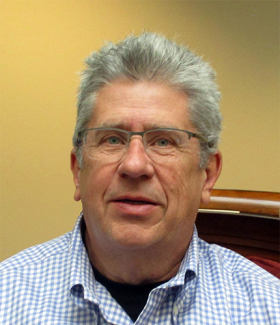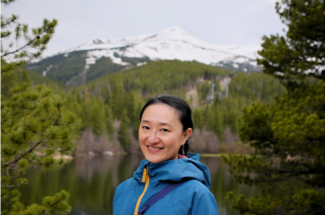I am the Co-chair, along with Hendrik Tolman, of the Unified Forecast System – Steering Committee (UFS-SC), one of the governance bodies in NOAA’s emerging community modeling effort. The overall goal of the UFS activity is to have a unified forecast system that can be configured to meet the many applications in NOAA’s product suite.
Director's Corner
NOAA’s emerging effort in community modeling
The UFS-SC is a review, coordination, and decision-making body, with major milestones and the schedule of the Environmental Modeling Center (EMC) applications a foundational consideration. The UFS-SC approves strategic direction and strategic plans for the UFS and recommends the content and development path of the production suite. More information on the UFS-SC can be found at: https://www.earthsystemcog.org/projects/ufs-sc/.
For many years the forecasts of the National Weather Service (NWS) have been criticized as being of less quality than those of the European Center for Medium-range Weather Forecasts. Much of the public criticism has been based on hurricane track forecasts from the global, medium-range forecast system. In both weather and climate modeling, the Europeans have been better able to organize and focus their activities. As I wrote in the Washington Post in 2013 “To be the best in weather forecasting: Why Europe is beating the U.S.”, our research community is fragmented. We find it difficult to overcome this fragmentation and focus research advances on operational applications.
The forecast mission of the NWS is far more complex than the medium-range, global forecast system. Looking to the future it will require models that couple atmospheric, oceanic, land, chemical, and cryospheric processes. These models will need to operate, for some applications, at cloud-resolving scales. The U.S. modeling research community holds excellence in all of these fields, and leveraging this expertise into operational systems to improve environmental security is a major motivation.
NOAA has taken some important steps to improve its operational modeling. The Strategic Implementation Plan (SIP) has become the foundation of the evolving modeling system. The plan is reviewed and updated on a regular basis. It is central to the Steering Committee’s deliberations, linking the operational requirements to research outside of NWS’s programmatic domain.
The selection of the FV-3 dynamical core and the cubic-sphere grid as a primary algorithm of the atmospheric model was an important scientific and computational step. ( See, “The Weather Service just took a critical first step in creating a new U.S. forecasting model” ) The selection was also an important organizational and managerial step; it facilitates the focus of activities in atmospheric physics on predictive problems in a controlled scientific environment.
Another decision by NOAA has an important strategic benefit. The NOAA Environmental Modeling System (NEMS) is a community-based, software infrastructure that supports multiple applications. For more than a decade, NOAA has participated with other agencies in evolving this infrastructure and integrating model components into a common architecture (“The Earth System Prediction Suite: Toward a Coordinated U.S. Modeling Capability” – BAMS 2016 ). This approach supports community participation in a software environment that advances scientific integrity and robustness. It allows sharing of algorithms and intellectual expertise.
NOAA has also been seeking to formalize a relationship with the National Center for Atmospheric Research (NCAR), which is a recognized leader in community modeling. With these decisions at hand, NOAA has improved its position to develop its world-class suite of predictive products.
The community governance is still evolving. Indeed, it was recognized from the beginning that a rising role of NOAA as a partner in the U.S. community modeling culture could not be defined as a hierarchical management structure. The UFS-SC has its role at the interfaces of NOAA’s operational and research missions and the broader research community. The organizational and cultural changes required to deliver the UFS will take time; there are gaps to fill and barriers to overcome. Never before in my career have the decisions been made and the leadership aligned in such a way to make such advances in modeling possible. This is an exciting time with reasons to be optimistic.
Contributed by Ricky Rood.
Richard B. Rood is a Professor at the University of Michigan. At NASA, he managed modeling, data assimilation, and high-performance computing to provide products for NASA’s observational missions and campaigns. He was detailed to the Office of Science and Technology Policy from 1998 – 2001 to develop strategies for modeling and computing.
Community Connections
The DTC helps the research community enhance the GSI/EnKF operational data assimilation system
Gridpoint Statistical Interpolation (GSI)/Ensemble Kalman Filter (EnKF) are operational data assimilation systems, open to contributions from scientists and software engineers from both operations and research. The development and maintenance of NOAA GSI/EnKF data assimilation systems are coordinated and managed by the Data Assimilation Review Committee (DARC), which incorporates all major GSI/EnKF data assimilation development teams in the United States within a unified community framework. DARC established a code review and transition process for all GSI/EnKF developers, reviews proposals for code commits to the GSI/EnKF repository and ensures that coding standards and tests are being fulfilled. Once DARC approves, the contributed code is committed to the GSI/EnKF code repository and available for operational implementation and public release.
The Developmental Testbed Center (DTC) Data Assimilation (DA) Team serves as a bridge between the research and operational communities by making the operational data assimilation system available as a community resource and by providing a mechanism to commit innovative research to the operational code repository. Prospective code contributors can contact the DTC DA helpdesk to prepare, integrate, and document the expected impact of their code and ensure that any proposed code change meets GSI coding standards. They can also apply to the DTC Visitor Program for their DA research and code transition.
Since the code transition procedures were established, the DTC DA team has helped many researchers contribute code to the repository:
-
NOAA/GSD and NCAR MMM scientists improved chemical initial conditions for WRF-Chem and GO-CART forecasts by using WRF-Chem and GOCART as background to analyze surface measurements of fine particulate matter (PM2.5) and MODerate resolution Imaging Spectroradiometer (MODIS) total Aerosol Optical Depth at a wavelength of 550 nm. These functions are available through the DTC GSI release and have been used by many researchers including Barbara Scherllin-Pirscher from the Central Institute for Meteorology and Geodynamics, Vienna, Austria. Scherllin-Pirscher is a DTC visitor working to further enhance GSI chemical analysis by assimilating vertical light detection and ranging (LIDAR) measurements to improve the vertical aerosol representation in WRF-Chem forecasts.
-
The DTC hosted Mengjuan Liu from the Shanghai Meteorological Service to study how to use GSI to improve the surface data analysis. Liu found the conventional observation operator can introduce large representativeness errors when surface conditions are inhomogeneous, such as on coastlines. An improved forward model for surface observation along the coastline was developed and added to GSI repository. This new forward observation operator was used in the recent operational Rapid Refresh/High-Resolution Rapid Refresh (RAP/HRRR) update.
-
The DTC Visitor Program hosted Ting-Chi Wu from CIRA/CSU to add the capability to assimilate solid-water content path (SWCP) and liquid-water content path (LWCP), which are satellite retrieved hydrometeor observations from Global Precipitation Measurement (GPM) from the Goddard PROFiling algorithm (GPROF).
-
The DTC Visitor Program hosted Karina Apodaca from CIRA/CSU to incorporate two new lightning flash rate observation operators suitable for the Geostationary Operational Environmental Satellite (GOES)/Global Lightning Mapper (GLM) instrument in the GSI variational data assimilation framework. One operator accounts for coarse resolution and simplified cloud microphysics in the global model to evaluate the impact of lightning observations on the large-scale environment around and prior to storm initiation. Another forward operator for use with non-hydrostatic, cloud-resolving models permits the inclusion of precipitating and non-precipitating hydrometeors as analysis control variables.
The GSI/EnKF code commit procedures established by DARC and the DTC successfully moves innovative contributions into the repository. The DTC and its Visitor Program is a great resource for the research community to introduce new techniques and model components to advance numerical weather prediction technology.
Contributed by Ming Hu and Chunhua Zhou.
PROUD Awards
Weiwei Li is a Project Scientist at NSF NCAR Research Applications Laboratory. She led the DTC Visitor Program and co-leads DTC’s UFS Physics Testing and Evaluation (T&E) project. Her broad scope of work includes leading the model physics performance assessment, advancing the Common Community Physics Package (CCPP), and fostering collaborations across the weather and climate modeling community.
Trained as a tropical meteorologist, Weiwei consistently strives far beyond her original expertise since joining the DTC. She leads the air–sea interaction component of the T&E effort, made the MPAS physics CCPP-compliant, and incorporated the Cold-air Outbreaks in the Marine Boundary Layer Experiment (COMBLE) dataset into the CCPP Single Column Model case library—conducting in-depth analyses along the way. Her adaptability and technical skill have been key to evaluating physics innovations across diverse processes and regimes in UFS applications.
In her role as Visitor Program lead, Weiwei instantly partnered with the DTC Director to develop a fresh set of hosting guidelines—an initiative that will strengthen the program for years to come. She also organizes and leads weekly DTC Physics T&E meetings, ensuring steady progress, fostering collaboration, and maintaining the team connection to emerging priorities in the physics development community. Aside from her numerous leadership and management duties, she continues to produce high-quality scientific analyses and technical contributions.
Weiwei’s impact at DTC is not only from her expertise, but also from her energy, curiosity, and collaborative spirit. Whether in science, leadership, or building community, she exemplifies the blend of dedication and excellence that drives DTC forward.
Copyright © 2025. All rights reserved.

